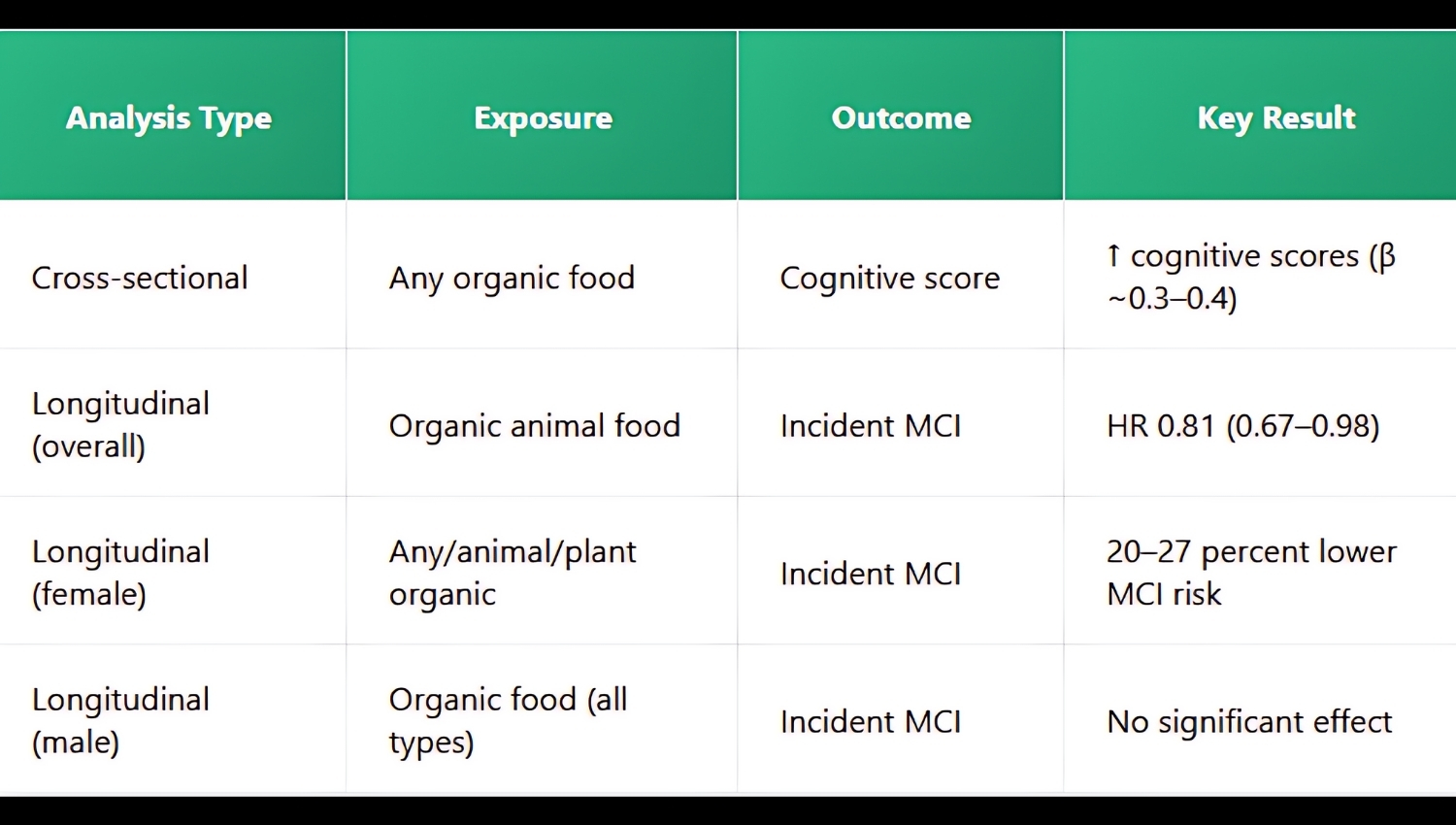03
Oct
Study Reports Higher Cognitive Scores with an Organic Diet

(Beyond Pesticides, October 3, 2025) A study published in European Journal of Nutrition finds that consumption of organic animal-based and plant-based foods is positively associated with higher cognitive scores. Among women, there was both better cognitive function before testing (at baseline) and up to a 27 percent lower MCI [mild cognitive decline] score over the course of the study period for participants identifying as organic consumers, even if there was consumption of just one of the seven food categories.
Over the 3.7-year study period, the authors conclude, “Our study found that organic food consumption was associated with higher cognitive scores for both sexes, yet the association with reduced incidence of MCI was observed exclusively in female participants.”
While it is important to note that additional research is necessary to corroborate these results, these findings support the calls of environmental and public health advocates across the country who are calling for political leaders to take action by mandating organic-sourced meals for public institutions and programs, including National School Breakfast and School Lunch Program, hospitals, public universities, and other institutions.
Background and Methodology
The data for this study is drawn from robust datasets for the U.S. population, including 2012 data from University of Michigan’s Health and Retirement Study (HRS) – “a longitudinal panel study that surveys a representative sample of more than 20,000 Americans over the age of 50 every two years” —as well as an HRS supplemental study, the Health Care and Nutrition Study (HCNS)—“ utilizing validated Food Frequency Questionnaires (FFQ) to assess food consumption and nutritional status, conducted in 2013.” In terms of sample selection, 6,077 participants were selected for a cross-sectional analysis, and 4,882 participants were selected for a longitudinal analysis. Participants from the initial pool (8,021 participants) were excluded from the two analyses based on age, conflicting responses for organic food consumption, negative sample weights, extreme total energy intake, or missing baseline cognitive data. The median follow-up between studies was 3.7 years because of the structure of HRS and differing follow-up durations for participants based on when they were last observed, identification of cognitive impairment, or when they dropped out of the study.
Organic food consumption was measured based on two questions in the FFQs:
- “In the last year, have you eaten any organic food? (Yes/No)”
- “Which organic food have you eaten in the last year?” with categories including milk, eggs, meat, fruits, vegetables, bread/cereals, and prepared frozen meals.
If participants answered yes to question one, they are considered organic food consumers, with foods categorized based on whether they are animal-based (e.g., milk, eggs, meat) or plant-based (e.g., fruits and vegetables). The Organic Diet Diversity Score (ODDS) was calculated as the number of food categories participants consumed out of the seven total food categories (milk, eggs, meat, fruits, vegetables, bread/cereals, and prepared frozen meals). A high ODDS score is greater than three, whereas a low score is less than three.
The researchers used a methodology from previous studies to measure cognitive function and gleaned scores for measuring mild cognitive impairment (MCI) through the “Telephone Interview for Cognitive Status” (TICS). TICS measures memory (immediate and delayed 10-noun recall), working memory (“the number of times participants can consecutively subtract seven from 100 over five trials”), and mental processing speed (counting backwards by multiples of 10). The Langa-Weir classification method was utilized for HRS participants to organize three score ranges: dementia (0-6), middle cognitive impairment (7-11), and normal cognitive function (11-27).
There are other covariates (independent variables that may impact the study results) that were kept in mind, including participant demographics, health behaviors, existing medical conditions, and diet quality (based on the Alternative Mediterranean Diet Score). HR stands for hazard ratio, a score used to analyze mild cognitive impairment over time. A hazard ratio of less than one indicates decreased risk, while a HR greater than one indicates increased risk. For further information on statistical analyses, see page 4 of the study.
The authors of this study are based at Southern Medical University and Guangdong Provincial Key Laboratory of Tropical Disease Research in Guangdong, China. They declared that no additional funding was received for drafting this study.
Results
“[W]e revealed a clear relationship between a higher level of organic dietary diversity with lower incident cognitive impairment among females,” the researchers state. Sixty-one percent of cross-sectional participants identified as organic food consumers. In terms of ODDS scores, female participants with greater diversity of organic food consumption “had better cognitive scores” and “only female consumers with high ODDs were associated with lower incident MCI.” The researchers conducted sensitivity analyses to test the robustness of their findings: “Null associations between consuming organic food (including both sub-categories) and MCI incidence were detected among male consumers.” After conducting a Kaplan-Meier analysis (see Figure 2, page 7, in the study to learn more), the researchers concluded that “there was no association detected among male consumers.”

“After a median follow-up of 3.7 years,” the hazard ratio (HR) for organic animal food consumers was 0.81. This finding is noteworthy because it indicates that “organic animal food consumption was significantly associated with declined incident MCI [meaning that there was a lower risk of developing mild cognitive decline over time.” As a result, with a 95 percent confidence interval (statistical significance), organic consumers in this study had a 19 percent lower risk of developing mild cognitive impairment over time, after adjusting for the covariates. The beta coefficients (β) represent the association between organic food consumption and cognitive test performance at baseline (before tests were conducted). In other words, a beta coefficient of ~0.3–0.4 means that, on average, organic consumers score about 0.3 to 0.4 points higher on the cognitive tests compared to non-organic consumers. The beta coefficients for organic animal-based food and plant-based food were .35 and .38, respectively. While this appears marginal, the findings were statistically significant and accounted for confounding health variables. Included above is a summary table listing the analysis type (cross-sectional versus longitudinal), exposure to organic food, tested outcome (cognitive score, incident MCI), and key results.
Previous DN
Adopting a fully organic diet can reduce pesticide levels in urine within just two weeks “by an average of 98.6 [percent]” and facilitate faster DNA damage repair relative to a diet of food grown with chemical-intensive practices, according to findings from a randomized clinical trial published in Nutrire. Researchers at the Federal University of Rio Grande (Brazil) conducted this study, which was a double-blind randomized controlled trial, meaning that neither the researchers nor the participants knew who was going to be assigned to each group, minimizing bias. (See Daily News here.)
A 2023 study published in Environmental Health Perspectives finds urinary levels of glyphosate significantly decreased through an organic diet for pregnant individuals living further than 0.5km (~1,640 feet) from an agricultural field. However, the study finds that adopting an organic diet among pregnant individuals living closer than 0.5km to an agricultural area does not significantly decrease glyphosate levels, indicating alternative sources of contamination outside of diet. (See Daily News here.) A 2020 study published in Environmental Research finds that glyphosate levels can be reduced by up to 70 percent after just one week on a fully organic diet. Research participants comprised individuals from four geographically and racially diverse U.S. families hailing from Baltimore (Maryland), Atlanta (Georgia), Minneapolis (Minnesota), and Oakland (California). Urine samples were collected during a six-day period in which all subjects consumed a diet of conventionally grown and raised foods, and again during a six-day period of only organic food consumption. Although the study sample was small (16), the number of urine samples assayed (158) was sufficient for researchers to make statistically significant conclusions. (See Daily News here.)
To learn more about the connection between organic land management and public health, see “Cultivating Healthy Communities” – the 2021 National Pesticide Forum hosted by Beyond Pesticides and Icahn School of Medicine at Mount Sinai.
Call to Action
Beyond Pesticides has developed and actively maintains the Keeping Organic Strong resource hub, a one-stop shop for you to learn about changes in organic regulations. There is currently an opportunity for the public to weigh in on the integrity of national organic standards, as the National Organic Standards Board (NOSB) convenes to discuss key issues and allowed materials in organic agriculture. The deadline for written comments on the Fall 2025 issues is 11:59 pm EDT on October 8, 2025, and the Public Comment Webinars will be held on October 28 and 30, 2025, from 12 pm to 5 pm EDT.
The public can see a discussion of issues before the board and submit comments (using Beyond Pesticides’ positions as a foundation) by October 8. To submit comments, please click HERE. For more background, see Keeping Organic Strong and the Fall 2025 issues page. The Fall NOSB meeting will be held both in person in Omaha, Nebraska, and virtually, via live-stream from November 4, 2025, to November 6, 2025.
You can also take action here by contacting your members of Congress to co-sponsor and support organic bills that have recently been introduced in the first year of the 119th Session of Congress.
All unattributed positions and opinions in this piece are those of Beyond Pesticides.
Source:Â European Journal of Nutrition










